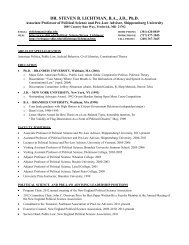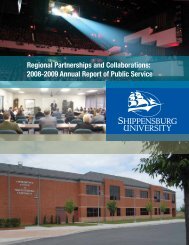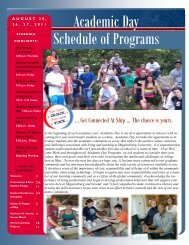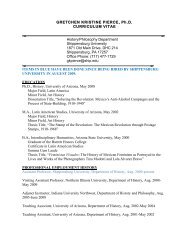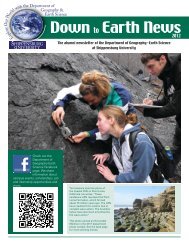Complete Issue - Shippensburg University
Complete Issue - Shippensburg University
Complete Issue - Shippensburg University
- No tags were found...
Create successful ePaper yourself
Turn your PDF publications into a flip-book with our unique Google optimized e-Paper software.
Evy Johanne Håland,: The “Life-giving Spring” 5312. They also tell that today the icon is to be found in the churchdedicated to the Panagia Crysospēliōtissa, in the neighbourhoodof Omonia square. They also call it Eirinē (i.e. Peace) or the Sleep,i.e. the Death.13. In 1992 the ritual was not performed. Some days before thefestival Eirinē and Panagiotis were cleaning and tidying up bothchurches, but Eirinē goes to the church in Monastiraki on thefestival day. She does not tell why, but it might be that they havedifficulties when trying to find a priest. Early in the morning, awoman reaches the entrance to the theatre of Dionysos, asking ifthe ceremony is going to be performed. But, she gets a negativeanswer.14. Over the table is a Byzantine wall-painting representing AgiosAthanasios from the 16th century. Several dates are alsoscratched on the rock.15. So one may suggest that even if the cult dedicated to Athenaon the top of the Acropolis was prohibited in the 5th century,when Athena’s Parthenon was transformed into a churchdedicated to the Panagia after the termination of the Panathenaiain 410 A.D., it has continued in one of the cave-churches on theslope of the same rock.16. I observe a cross, which looks like a phallus, and they tell thatit is sewn.17. Cf. the story behind the “split column”, Economdes 1986:22-24.18. It is worth mentioning that after a while the leader of theguards working at the Acropolis-area comes around. He got acopy of my permission-letter to do research in the caves. All theway, I experienced that they found it quite incomprehensible thatI was as interested in talking with the people performing theirreligious rituals as with the archaeologists.19. Cf. ancient Greek death-cult and the belief that the power ofthe dead was most strongly experienced in the neighbourhoodof the grave, cf. Garland 1985: 4 and fig. 1 for a parallel to thebones of the saints in the cave.20. Panagiotis also tells that the best candles are made of honey,cf. the beeswax-candles on Aegina.21. See also Tsotakou-Karbelē 1991: 98 f.; Megas 1992: 184-187.22. May Day is also celebrated with other particular customs, i.e.people gather spring flowers. With these they make wreaths andhang them on their front door.23. Cf. Håland 2007: particularly ch. 2. For the following, cf. alsoHerzfeld 1986, 1992.24, Arriving directly with a delayed plane from Karpathos, I waslate, and the guards would not let me enter: They take me forone of the other ordinary tourists who are persistent outside theentrance-gate, even thought most of them know why I am here.They say that, “the festival is only celebrated for the Greeks.”Finally, they admit me into the area because I am able to presentthe letter I got from the Acropolis-authorities, giving mepermission to visit the caves in connection with my research.25. Cf. Herzfeld 1992: for the term “disemia”, a two-way-facingsystem of meanings that can be part of a public discourse, cf.also Dubisch 1995: ch. 9 for the distinction between insider andoutsider, dikoi (our own) and xenoi (strangers or foreigners). Cf.Håland 2007: ch. 2 f., 6, forthcoming.26. See also Håland 2003: fig.3 and 2005: fig.8.27. See also Håland 2003: fig.4; Travlos 1971: 127, 138, fig.178,cf. figs.192 f. Fig. 192 is also dedicated to Pan, cf. the following.Also Hdt. 6.105, cf. Ar. Lys. 720-723; Eur. Ion. 492-502, see alsoMen. Dysk. 432-434. For the Athenian Acropolis, see for exampleHurwit 2004.28. Travlos 1971: 127. The ancient Athenian calendar year beganin the summer of one of our years and ended in the summer ofthe next, accordingly ancient dates are often expressed inslashed terms.29. See Kasas and Struckmann 1990.30. Cf. Håland 2003, 2005, for the importance of the waternymphs.31 Travlos 1939/41: 35-68, cf. Travlos 1971: 128.32. Travlos 1939/41: 68.33. Loukatos 1982: 153.34. For Artemis’ connection with springs, see Håland 2003. In theAcropolis cave, she is worshipped with her brother Apollo, Paus.1.21,3.35. Cf. the cult dedicated to Agia Marina beneath the Hill of theNymphs at Athens were people fetch Holy water from the springconnected to the church sacred to Agia Marina, particularlyduring her festival on 17 July, Håland 2005, 2007.36. See Håland 2003, 2007, forthcoming for a more detailedaccount also for the following.37. Foskolos 1996 presents the most important miracles of theMegalochari of Tinos.38. Blum/Blum 1970: 59.39. See Håland 2003: fig.2.40. Loukatos 1985: 165.41. For the similarities between life-cycle passages and the ritualsperformed in connection with important passages during thecycle of nature, see Håland 2006, 2007.42. Håland 1990: ch. 2.43. Håland 1990: ch. 2 and 7.44. Quoted from Grunebaum 1981: 10.45. Cf. Blum/Blum 1970; Håland 1990, 2003, 2005 also for ancientmaterial.46. Blum/Blum 1970: 324, cf. Håland 2005: Agia Marina and theformer Nymphs. See also n.34 supra.47. For the relations between traditional popular religiosity andIslam see also for example, Bourdieu 1980; Eickelman 1981. Cf.also Grunebaum 1981.REFERENCES AND ABBREVIATIONSAlexiou, Margaret. 1974. The ritual lament in Greek tradition.Cambridge: Cambridge Univ. Press.Aristophanes (Ar.), trans. Benjamin Bickley Rogers. 1946 (1924).Vol. 3: The Lysistrata (Lys.), The Thesmophoriazusae, TheEcclesiazusae, The Plutus. The Loeb Classical Library.London: Heinemann.Blum, Richard, and Eva Blum. 1970. The dangerous hour. Thelore of crisis and mystery in rural Greece. London: Chattoand Windus.Bourdieu, Pierre. 1980. Le sens pratique. Paris: Les Éditions deMinuit.Clément d’Alexandrie, Les stromates (Clem. Al. Strom.), trans.Marcel Gaster/Claude Mondésert. 1951. Vol. 1. SourcesChrétiennes. Paris: Les Éditions du Cerf.Diodorus of Sicily (Diod.), trans. C. H. Oldfather. 1954. Vol. 6. TheLoeb Classical Library. London: Heinemann.Dubisch, Jill. 1995. In a different place: Pilgrimage, gender, andpolitics at a Greek island shrine. Princeton: PrincetonUniv. Press.Economides, Irene. 1986. Differeces between the ortodoxchurch and roman catholicism. 2 nd editon. Athens.Eickelman, Dale F. 1981 (1976). Moroccan islam: Tradition andsociety in a pilgrimage center. Austin/London: Univ. ofTexas Press.



